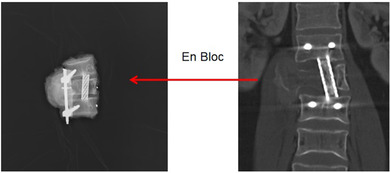- Record: found
- Abstract: found
- Article: found
Comparison of En Bloc Resection and Intralesional Excision for Re‐resection of Giant Cell Tumors of the Spine

Read this article at
Abstract
Objective
Re‐resection of spinal giant cell tumors is an exceedingly difficult procedure. Moreover, the prognosis of patients with en bloc resection or intralesional excision for re‐resection has rarely been reported. This study aimed to compare the prognostic value of en bloc resection with that of intralesional excision in patients undergoing re‐resection for giant cell tumors of the spine.
Methods
This retrospective analysis evaluated patients who underwent revision surgeries for relapse of giant cell tumors of the spine at our center between January 2005 and January 2021. Local progression‐free survival represents the duration between en bloc resection or intralesional excision and tumor recurrence. Neurological recovery, survival rates, local control, and complications were evaluated. The Kaplan–Meier estimator was used for survival analysis.
Results
A total of 22 patients (nine men and 13 women) with a mean age of 34.1 (range 19–63) years were included. Significant statistical differences were found in the local tumor recurrence rate between patients treated with en bloc resection and those treated with intralesional excision ( p < 0.05). The 5‐ and 10‐year local progression‐free survival rates were both 90% in the en bloc resection group, while in the intralesional excision group, the 5‐year local progression‐free survival rate was 80% with a 10‐year rate of 45.7%. The en bloc resection group had a lower local tumor recurrence rate than that of the intralesional excision group ( p < 0.05), but the former had a higher rate of complications ( p = 0.015).
Abstract
Our findings highlight the trade‐off between lower recurrence rates with en bloc resection and the higher risk of perioperative complications, helping clinicians make informed decisions when choosing the most appropriate surgical technique for the patients undergoing re‐resection for giant cell tumors of the spine.
Related collections
Most cited references21
- Record: found
- Abstract: found
- Article: not found
Giant cell tumor of the mobile spine: a review of 49 cases.
- Record: found
- Abstract: not found
- Article: not found
Surgical outcomes of patients with diffuse-type tenosynovial giant-cell tumours: an international, retrospective, cohort study
- Record: found
- Abstract: found
- Article: not found
